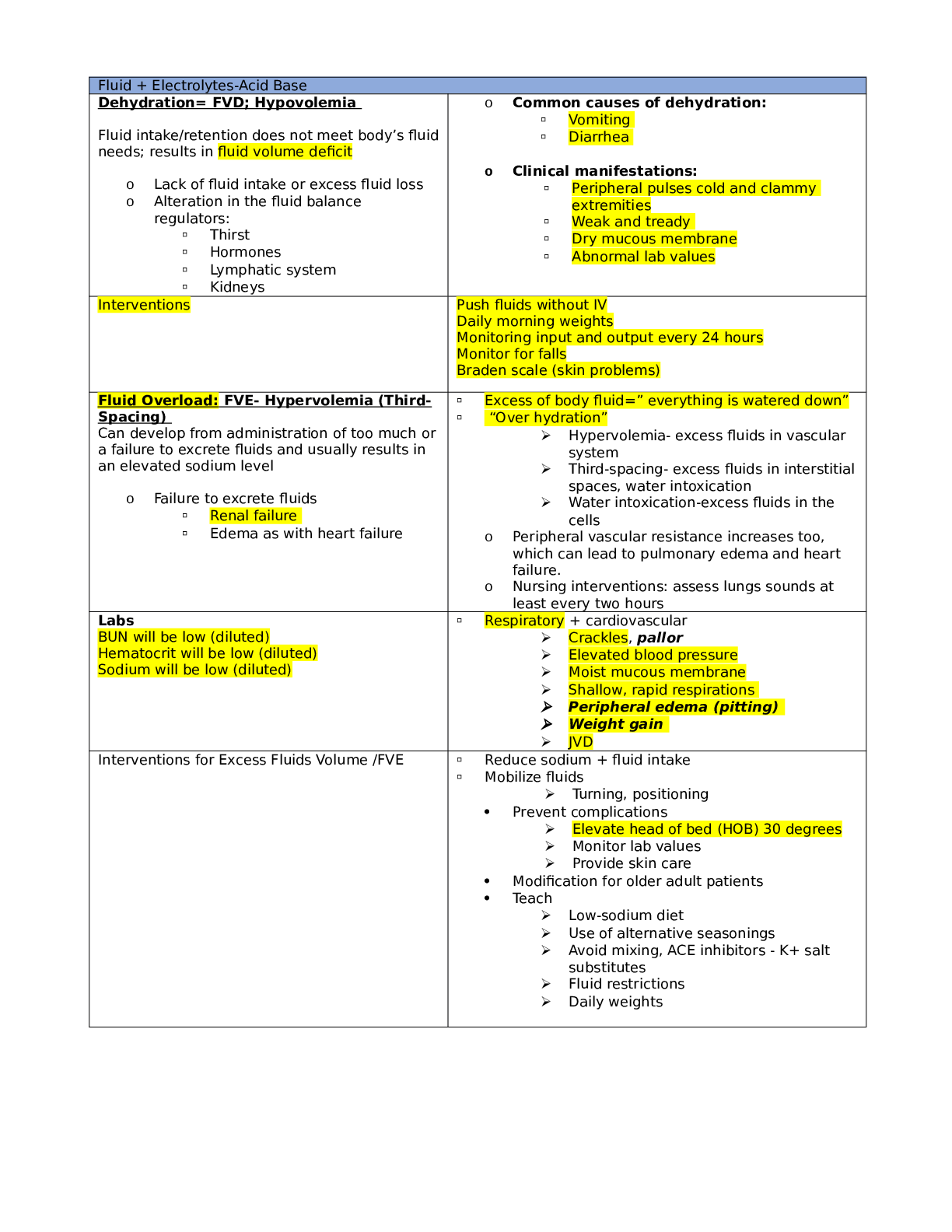Fluid + Electrolytes-Acid Base
Dehydration= FVD; Hypovolemia
Fluid intake/retention does not meet body’s fluidneeds; results in fluid volume deficito Lack of fluid intake or excess fluid loss
o Alteration in the fluid balance
regulators: Thirst
Hormones
Lymphatic system
Kidneys
o Common causes of dehydration: Vomiting
Diarrhea
o Clinical manifestations:
Peripheral pulses cold and clammy extremities Weak and tready Dry mucous membrane Abnormal lab valuesInterventions Push fluids without IVDaily morning weightsMonitoring input and output every 24 hoursMonitor for fallsBraden scale (skin problems)Fluid Overload: FVE- Hypervolemia (Third�Spacing)
Can develop from administration of too much or
a failure to excrete fluids and usually results in
an elevated sodium level
o Failure to excrete fluids
Renal failure
Edema as with heart failure
Excess of body fluid=” everything is watered down” “Over hydration” Hypervolemia- excess fluids in vascular
system
Third-spacing- excess fluids in interstitialspaces, water intoxication Water intoxication-excess fluids in the cells
o Peripheral vascular resistance increases too,
which can lead to pulmonary edema and heart failure.
o Nursing interventions: assess lungs sounds at
least every two hours
LabsBUN will be low (diluted)Hematocrit will be low (diluted)Sodium will be low (diluted) Respiratory + cardiovascular
Crackles, pallor
Elevated blood pressure Moist mucous membrane Shallow, rapid respirations
Peripheral edema (pitting)
Weight gain
JVDInterventions for Excess Fluids Volume /FVE Reduce sodium + fluid intake
Mobilize fluids Turning, positioning
Prevent complications Elevate head of bed (HOB) 30 degrees Monitor lab values
Provide skin care
Modification for older adult patients Teach
Low-sodium diet
Use of alternative seasonings Avoid mixing, ACE inhibitors - K+ salt substitutes
Fluid restrictions Daily weights Electrolyte Imbalances
Sodium- 135-145 mmol/L Responsible for where salt goes water followsHyponatremia:
Most common electrolyte disorder; it is directly
related to changes in the fluid volume status as
sodium moves into cells + potassium moves intoECF, which results in INTRACEULLAR EDEMA.
o Sodium <135 (less than)
o Causes:
abnormal loss or excretion of sodium
Water imbalance Hormonal imbalance (such as excess
ADH) Hypothyroidism Renal failure
Diuretics; excessive use is a common
cause of hyponatremia as well as GI
wound drainage.
Diarrhea
Vomiting
Wound drainage
Burns
Excess perspiration
o Risk: Seizures + death if electrolytes not corrected
o S/S:
Headache + apprehension Confusion; Hypotension (especially
orthostatic) Hallucinations, seizures,
coma, + even death may occur. o The decrease in vascular volume presents as
hypotension, tachycardia, + weak thready
pulse.
o Treatment: Water restriction, administer saline
solution IV slowly if FVD, furosemide if fluid
overload, TX underlying cause
o Nursing DX: FVD, FVE, Risk for disturbed
thought process, decreased cardiac output o Fall precautions
Hypernatremia: Sodium/ Na+: >145 (greater
than)
Associated with high mortality rate. It occurs in
about 1% of hospitalized patients + usually
associated with water loss (watery diarrhea) or
sodium gain.
o Causes: insufficient water intake, insufficient
sodium excretion due to hormone imbalance, renal failure, corticosteroids, increased sodiumintake or increased water loss because of fever, hyperventilation, increased metabolism,
+ dehydration owing to sweating, vomiting, or diarrhea
o Risk: Hypervolemia associated with hypernatremia in some patients may cause HF + or pulmonary edema
S/S: o Confusion
o Weight gain due to fluid retention
o Restlessnesso Irritability
o Agitation owing to increase neural activity with normal or low fluid volume
Read More


